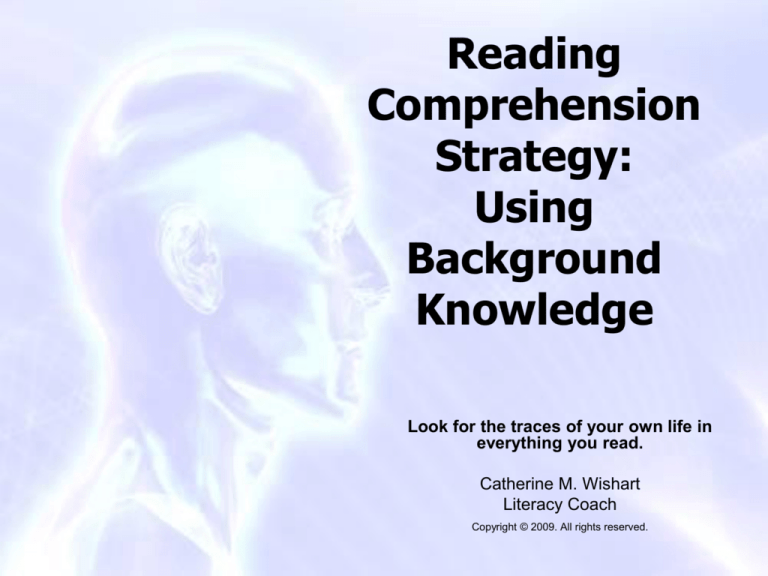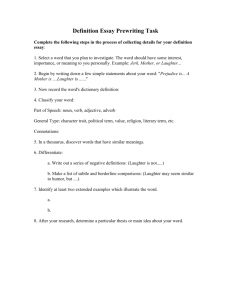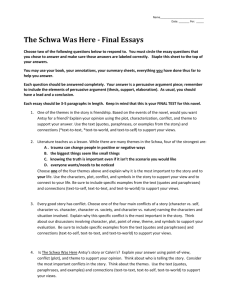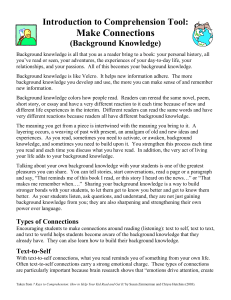
Reading
Comprehension
Strategy:
Using
Background
Knowledge
Look for the traces of your own life in
everything you read.
Catherine M. Wishart
Literacy Coach
Copyright © 2009. All rights reserved.
“A story has as
many versions as
it has readers”
(John Steinbeck).
What is Background
Knowledge?
• Do you remember a particular vacation you took that
was especially great?
• Do you remember the last book you read that you really
liked?
• Do you remember a family event that everyone in the
family still talks about?
• Do you remember a special friend from your childhood?
• Do you remember a specific movie that you really
enjoyed?
• All of these events, experiences, memories make up
your own personal background knowledge.
Activating Background
Knowledge
• When reading a text, make a personal
connection:
–
–
–
–
–
That reminds me of when….
That’s how my family….
My friend used to….
I tried to do something like that when I….
I act like that character when I….
• When you make a personal connection to a text,
you are making a text-to-self connection.
• Text-to-self connections make the reading more
real and more important for the reader.
Text-to-Self Connections
“A Child’s Laughter”
One of a kind this cheerful sound
A child’s laughter wherever it’s found
From the giggling of a baby in a playpen
To the laughter of a toddler again and again
A child’s laughter can bring a smile
To one who hasn’t done so in such a long while
I know because that one was me
Until my daughter’s laugh set mine free
A child’s laughter can bring out the best
Of most every man when he’s depressed
Cause his spirit that’s fallen to soar
Until at last he laughs once more
Harry J. Couchon Jr. Poemhunter.com
What Does the Poem Remind You Of?
• Do you remember a time when a child was
laughing – maybe you as a child?
• Do you remember a time when someone was
especially sad, but a child said or did just the
right thing to change his or her mood?
• Do you recall a special child-parent moment that
ended up in laughter?
• Answering any of these questions when thinking
about the poem means you have drawn on your
background knowledge to make the poem more
real.
• Answering any of these questions means you
have made a text-to-self connection.
Accessing Text-to-Text
Connections
• Text-to-text connections involve linking
two or more different texts you have
personally read.
• When making a text-to-text connection,
you find what is similar and familiar in
these texts.
• Finding the similarities makes learning and
understanding easier.
Background Knowledge:
Text-to-Text Connections
“Shopping at the Hospital”
Mom and Dad were very excited – their new son had
finally arrived. Like all parents, they thought Matthew was
perfect. Today, 2 ½ year old Dawn would meet her new
baby brother for the first time. Dawn dressed up in a fancy
new dress to meet her brother. Mom, Dad, and Dawn all
strolled down to the nursery to see Matthew. Dad lifted up
Dawn so she could see all the babies. Mom beamed and
said, “See that baby right here in front of us? That’s your
new baby brother.” Dawn started to pout. She said, “But
Mommy, I don’t want that one with no hair! I want that one
with the pretty curly hair!”
How Do the Poem and Story
Connect?
• Text-to-text connections:
– Both the poem and the story are about laughing and
happiness
– Both the poem and the story are about children and
how they see the world
– Both the poem and the story show how adults react to
children
• If you had read the poem first, you could use
your background knowledge about children’s
laughter and its effects on adults to understand
the story. This connection is a text-to-text
connection.
Text-to-World Connections
• “Books, articles, and stories that make you
think of something beyond your own life
help you create text-to-world connections”
(Zimmermann and Hutchins, 2003, p. 53).
• Text-to-world connections are often the
most difficult to make.
• Text-to-world connections help you learn
about the world from what you read.
Practicing This Strategy
• The short story, “The Puzzle,” is continued
on the next slide.
• Read this portion of the story carefully.
You may also decide to review previous
portions of the story to assure you recall
the highlights of the characters and the
plot.
Making Connections:
“The Puzzle” by Anonymous
Pugh explained.
“I observed that box on a tray outside a second-hand furniture shop. It struck my eye. I took it up. I examined
it. I inquired of the proprietor of the shop in what the puzzle lay. He replied that that was more than he could
tell me. He himself had made several attempts to open the box, and all of them had failed. I purchased it. I
took it home. I have tried, and I have failed. I am aware, Tress, of how you pride yourself upon your ingenuity.
I cannot doubt that, if you try, you will not fail.”
While Pugh was prosing, I was examining the box. It was at least well made. It weighed certainly under two
ounces. I struck it with my knuckles; it sounded hollow. There was no hinge; nothing of any kind to show that
it ever had been opened, or, for the matter of that, that it ever could be opened. The more I examined the
thing, the more it whetted my curiosity. That it could be opened, and in some ingenious manner, I made no
doubt – but how?
The box was not a new one. At a rough guess I should say that it had been a box for a good half century;
there were certain signs of age about it which could not escape the practiced eye. Had it remained unopened
all that time? When opened, what would be found inside? It SOUNDED hollow; probably nothing at all – who
could tell?
It was formed of small pieces of inlaid wood. Several woods had been used; some of them were strange to
me. They were of different colors; it was pretty obvious that they must all of them been hard woods. The
pieces were of various shapes – hexagonal, octagonal, triangular, square, oblong, and even circular. The
process of inlaying them had been beautifully done. So nicely had the parts been joined that the lines of
meeting were difficult to discover with the naked eye; they had been joined solid, so to speak. It was an
excellent example of marquetry. I had been over-hasty in my deprecation; I owed as much to Pugh.
What Connections Do You
Make?
• Reread this portion of “The Puzzle” to
yourself.
• Think about what kind of connections you
make to parts of the story.
• Complete the double-entry journal page.
Choose your own quotes from the story on
which to comment.
• Be prepared to discuss your connections
with this part of the story in class.
Questions to Guide Making
Background Knowledge
Connections
• Does anything here remind me of something that
happened in my life?
• What do I know now about this topic that I didn’t know
before I read this article?
• How are these two texts related?
• How can I use my background knowledge to predict
what may happen next?
• Can I get a movie going that shows how my own life
experiences and this story have connections?
• What does this article tell me about the world? Do I
agree with what the author says, or do I disagree? Why?
The K-W-L Chart for Non-Fiction
Reading
What I Know
What I Want
to Know
What I
Learned
The K-W-L Chart is a great way to access background knowledge and to track
new learning. When reading about a new topic, brainstorm a list of what you
already know about the topic. Then brainstorm a list of what you believe you
want to learn about the topic. After reading, brainstorm a list of what you learned
that has added to your background knowledge for future reading.
A Simple Way to Build
Background Knowledge
• Spend some time in the children’s section
of the library!
– Important terms will be explained in simple
language
– Important ideas will be presented
– Your background knowledge will be increased
to make reading more difficult texts on the
topic easier to understand
“Remember only this one thing,”
said Badger. “The stories people
tell have a way of taking care of
them. If stories come to you, care
for them. And learn to give them
away where they are needed.
Sometimes a person needs a
story more than food to stay alive.
That is why we put these stories
in each other’s memory. This is
how people care for themselves.
-Crow and Weasel, Barry Lopez
(Zimmermann and Hutchins, 2003, p. 62).
References
• Anonymous. “The Puzzle.”
http://www.classicreader.com/book/1409/1/.
• Couchon, Harry J. Jr. “A Child’s Laughter.”
http://www.poemhunter.com/poems/laughter/.
• “Critical Perspectives: Reading and Writing about
Slavery.”
http://www.readwritethink.org/lessons/lesson_vie
w.asp?id=1060.
• Zimmermann, Susan and Hutchins, Chryse. 7
Keys to Comprehension. NY: Three Rivers Press,
2003.








